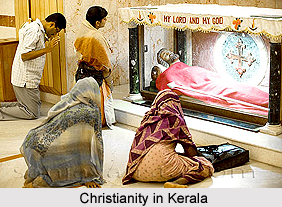 Christianity in Kerala is considered to be really old and many Keralites converted to Christianity much before St. Peter reached Rome. Thus, it can be said that Christianity in Kerala came around three centuries before it gained official recognition in Europe and became the established religion in Rome. Tradition has it that St. Thomas, the Apostle, reached Kerala in 52 AD and founded several churches along the Kerala coast. Pantaenus of Alexandria who visited Kerala in the second century found a flourishing Christian community there. The community was augmented in 345 by an influx of Syrian immigrants consisting of 400 Christians from 72 families of Baghdad, Nineveh and Jerusalem under the leadership of the merchant, Thomas of Cana.
Christianity in Kerala is considered to be really old and many Keralites converted to Christianity much before St. Peter reached Rome. Thus, it can be said that Christianity in Kerala came around three centuries before it gained official recognition in Europe and became the established religion in Rome. Tradition has it that St. Thomas, the Apostle, reached Kerala in 52 AD and founded several churches along the Kerala coast. Pantaenus of Alexandria who visited Kerala in the second century found a flourishing Christian community there. The community was augmented in 345 by an influx of Syrian immigrants consisting of 400 Christians from 72 families of Baghdad, Nineveh and Jerusalem under the leadership of the merchant, Thomas of Cana.
The rulers extended positive postures of sympathy and understanding to the Christians of Kerala. The Terisapalli copper plate inscription of 849 records a gift of a plot of land to the Teresa Church at Quilon by the ruler of Venad (Travancore) who was a feudatory of the Chera emperor. The prestige attached to the occasion is revealed by the fact that the imperial representative is also mentioned as having attended the ceremony. Representatives of trade corporations or merchant guilds like Anchuvannam and Manigramam were also present. Christian traders occupied important positions in these guilds. Further, the Thazhekad church inscription of the Chera emperor Rajasimha (1028-1043) refers to two Christian merchants Chathan Vadukan and Iravi Chathan, who were members of the Manigramam guild, certain high privileges having been conferred on them. The copper plate grant of 1225 issued by the Chera emperor Vira Raghava confers on Iravi Kortanan, a Christian merchant of Mahodayapuram, the headship of the merchant guild of the capital, in addition to several other rights and privileges.
This quiet growth of an integrated Christian tradition was interrupted by the advent of the Portuguese. In 1599, Archbishop Alexis de Menizes organised a synod at Udayam-peroor to cleanse the faith of accretions from the ambient culture. Some of the prohibitions were good and the canons of the council, incidentally, contributed to the evolution of Malayalam prose. But certain other proscriptions had an effect on further cultural development. The canons proscribed contact with Hindu religious literature. But as both literature and even grammar were steeped in Hindu religious associations, this proscription hampered for a time the attainment of high literary standards. Fortunately, two developments helped in winning back the community to the unified cultural life of the region. One was the discovery that identity of faith was not necessarily proof against racial tensions and that identity of race and shared traditions could be stronger than the schisms that might sometimes develop in a faith. The second was the advent on the scene of men with a profoundly integrative vision.
The advent of distinguished men of the order of the Society of Jesus was a much later phenomenon. The history of Syrian Christian Church of the state comprises the evolution of Roman Catholic groups and Syrian groups. With the advent of Christianity in Rome, a psychological conflict was precipitated. Kattakkayam`s Triumph of Jesus (1923), in twenty-four cantos and over three thousand seven hundred stanzas, is the longest Mahakavya in Malayalam language.



















